AT40 = 42.9% of stocks are trading above their respective 40-day moving averages (DMAs) (traded as low as 37.6%)
AT200 = 47.9% of stocks are trading above their respective 200DMAs
VIX = 19.0 (traded as high as 21.9)
Short-term Trading Call: neutral
Commentary
In my last Above the 40 post, I described how the stock market stumbled its way to the sharp edge of critical support levels for the major indices. Today, the indices got cut. The screaming headlines included news about the abuse of Facebook data and more political drama from Washington, D.C., but I strongly suspect these events were just convenient excuses for sellers to sell. The reaction to the Facebook news, a large 4% gap down, likely cut the will of buyers in the first part of the day. If the stock market were more healthy, I bet few if any of the headlines would have mattered to the originally scheduled programming.
The S&P 500 (SPY) gapped down below its 50-day moving average (DMA) and lost 1.4% at the close. The NASDAQ gapped down below its upper-Bollinger Band (BB) uptrend channel and lost 1.8% on the close. At its low, the NASDAQ perfectly tapped its 50DMA. The PowerShares QQQ ETF (QQQ) did the same as the NASDAQ but lost 2.1% on the day.
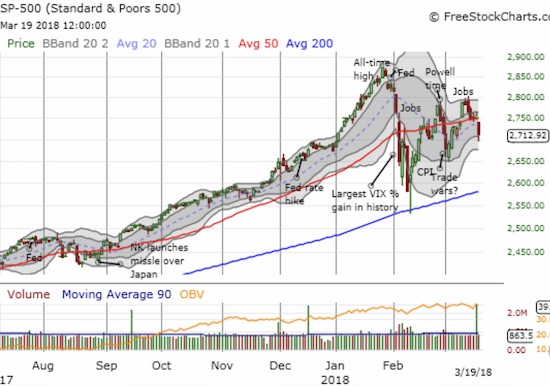

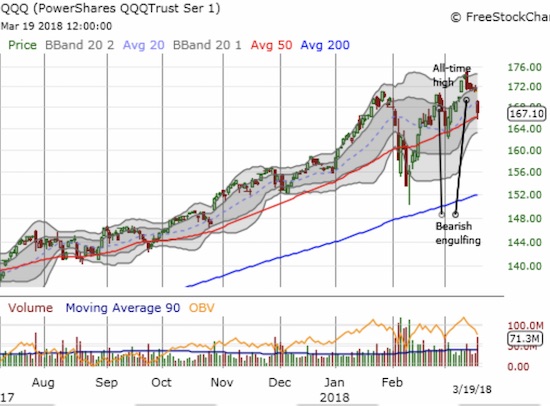
The iShares Russell 2000 ETF (IWM) once again out-performed the major indices. IWM bounced sharply off its 50DMA and closed with a loss of 1.0%.
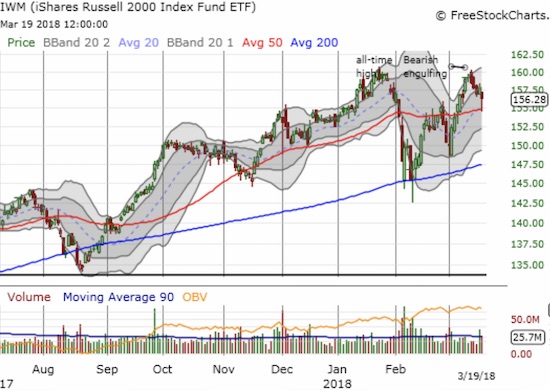
The bounces off intraday lows helped prop up AT40 (T2108), the percentage of stocks trading above their respective 40DMAs. AT40 dropped from 49.0% to 42.9% after trading as low as 37.6%. The volatility index, the VIX, faded sharply off its intraday high of 21.9 to end the day at 19.0. The 15.35 pivot now looks like a launching pad for this move. Based on the last two spikes in the VIX, I have to assume that near-term upside risk remains quite strong.

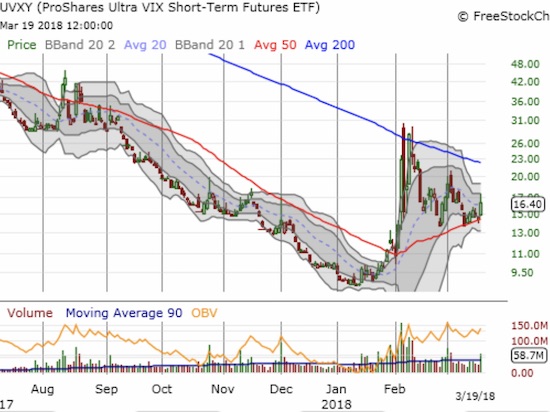
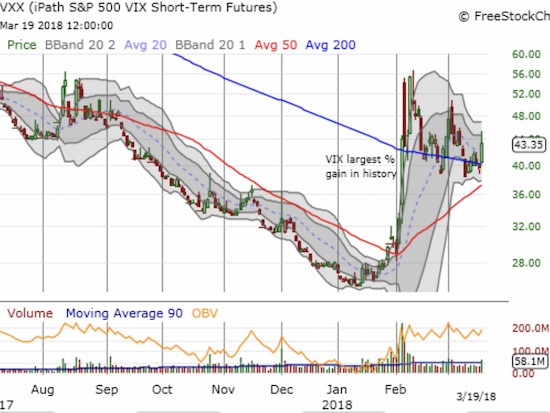
I am not sure which side of the fence is getting more exhausted: the buyers or the sellers. What I do know is that I have grown weary of switching the short-term trading call in an attempt to keep up with what increasingly looks like an extended period of market churn. I have decided to stand down for now. Since the S&P 500 broke below its 50DMA support, I downgraded from bullish and went back to neutral. I plan to leave the trading call there until AT40 reaches its next extreme – oversold or overbought – and/or the S&P 500 breaks out to a new all-time high (bullish). This change acknowledges that AT40 has little to say when the stock market is in a period of churn. If the NASDAQ and/or QQQ joins the S&P 500 to trade below its 50DMA, I will be a little more receptive to the growls of the bears even with the short-term trading call stuck in neutral.
My trading response to today’s dramatic action was a bit layered, but I tried to be as systematic as possible…
Although the S&P 500’s gap down below its 50DMA support flipped me bearish, the NASDAQ trading above its 50DMA compelled me to buy some dips. So I pursued a dual strategy. I first took profits on QQQ puts (they were paired with QQQ calls) and added to my weekly AAPL calls (probably a long shot with today’s 1.5% loss). I proceeded to buy call options expiring next week for FB and Goldman Sachs (GS). Low ball orders to double down on FB executed but not on GS. FB is pure speculation that within a week or so the stock will be in a sharp recovery mode. GS is a trade that I assume will work after the Fed hikes rates. I bought an Alphabet (GOOG) call expiring this week. Finally, I loaded up on SPY put options and took profits during the East Coast lunch hour. A limit order to fade iPath S&P 500 VIX ST Futures ETN (VXX) executed right under the intraday high of the day. This trade is part of my plan to fade volatility spikes ahead of the Fed proclamation on monetary policy on Wednesday.
Since I am already sitting on plenty of long positions now, my new trades will likely favor shorts and puts until I switch the short-term trading call to bullish.
CHART REVIEWS
Chipotle Mexican Grill (CMG)
CMG has traded in an unusually tight range for the past month. Now, a double squeeze is on: its 50 and 200DMAs are converging and the Bollinger Bands (BBs) are pinching together into what looks like a growing BB-squeeze. I am looking to play the breakout or breakdown from this pattern.
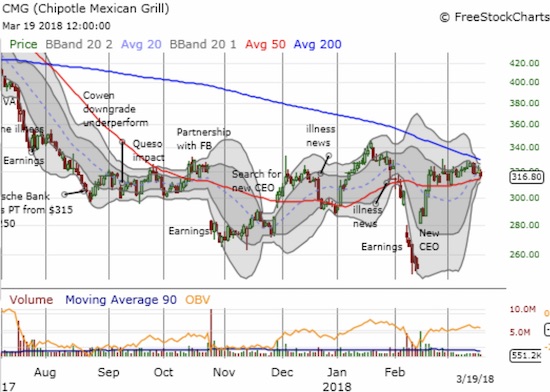
Facebook (FB)
I was quite surprised by the reaction in FB’s stock, but I guess the sellers were just looking for an excuse. The stock even cracked 50DMA support. Somehow, the stock gathered itself enough to close right on top of its 200DMA line of support. All eyes will be on FB trading for a while. As stated earlier, I am playing for a bounce in the next two weeks, but this trade is quite speculative. At the time of writing, news about the departure of FB’s head of cybersecurity sent the stock lower in after hours trading. Under the circumstances this seems to be a big deal, but it is something else FB will surely overcome in due time.

Equifax (EFX)
For good measure, I opened up a short position in EFX. This company was involved in a case of data abuse that far exceeds the scale and scope of FB, but the situation has almost entirely dropped off the radar. The stock made a valiant jump off its post-breach lows. Still, the declining 200DMA is delivering stiff resistance to any further advance. The stop-loss is a fresh post-breach high.
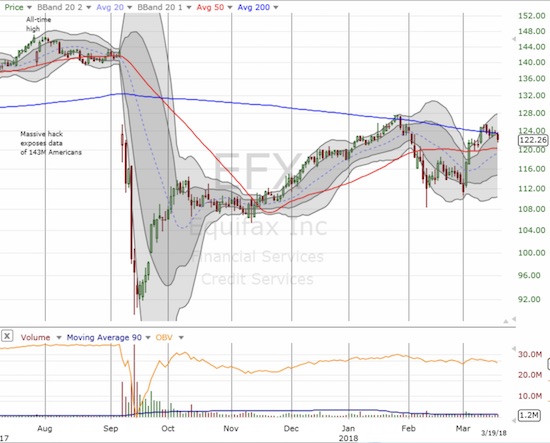
Other trades related to previous posts: N/A
— – —
FOLLOW Dr. Duru’s commentary on financial markets via email, StockTwits, Twitter, and even Instagram!
“Above the 40” uses the percentage of stocks trading above their respective 40-day moving averages (DMAs) to assess the technical health of the stock market and to identify extremes in market sentiment that are likely to reverse. Abbreviated as AT40, Above the 40 is an alternative label for “T2108” which was created by Worden. Learn more about T2108 on my T2108 Resource Page. AT200, or T2107, measures the percentage of stocks trading above their respective 200DMAs.
Active AT40 (T2108) periods: Day #22 over 20%, Day #11 over 30%, Day #7 over 40% (overperiod), Day #5 under 50%, Day #30 under 60%, Day #36 under 70%
Daily AT40 (T2108)

Black line: AT40 (T2108) (% measured on the right)
Red line: Overbought threshold (70%); Blue line: Oversold threshold (20%)
Weekly AT40 (T2108)

*All charts created using freestockcharts.com unless otherwise stated
The charts above are my LATEST updates independent of the date of this given AT40 post. For my latest AT40 post click here.
Related links:
The AT40 (T2108) Resource Page
You can follow real-time T2108 commentary on twitter using the #T2108 or #AT40 hashtags. T2108-related trades and other trades are occasionally posted on twitter using the #120trade hashtag.
Be careful out there!
Additional disclosure: long SPY shares and calls, short VXX, long FB calls, long GOOG call, long GS call
*Charting notes: FreeStockCharts.com uses midnight U.S. Eastern time as the close for currencies. Stock prices are not adjusted for dividends.

I see two important differences between the EFX and FB situations.
(1) The theft of EFX’s data, while a few times larger in number of people exposed, has properly faded because people (and law enforcement) are getting better at managing identity theft, which is the only known profitable use of that data. FB’s data was successfully mis-used to affect the outcome of the 2016 presidential election, and to date no defenses are in place against the exploits Cambridge Analytica developed.
(2) Data was stolen from EFX, but early on FB was complicit in the abuse of its data.
Both difference imply that EFX’s problems have been addressed and can be expected to fade with time, but FB’s have not and can be expected to fester, likely generating significant and continuing government actions to force FB to amend its practices.
On #1, we should be careful to note there is no proof that the election manipulation impacted the outcome. At least I have yet to see a study of the impact. People seem to assume that because there was manipulation, there was an impact. That could be giving the manipulators too much credit and voters too little credit, especially those on the fence who would need to be turned. Those are exactly the people who are, theoretically, being discerning instead of automatically voting by party. And I imagine it would be next to impossible to prove the impact especially since you would not get many people to actually self-report: “yeah, I saw this ad/post and that flipped me from Clinton to Trump.”
Even if EFX’s problems have been fixed (and I am extremely skeptical), the hackers have all the data they need for years on nearly the entire U.S. adult population. Yes we can manage identity theft with various programs and software, but most people have to pay for these services. The hackers will eventually figure out vulnerabilities in these systems as well. Once they start exploiting those (perhaps even hacking email accounts and suppressing identity theft alerts), we will really be vulnerable: we will be so used to thinking that everything is fine if the anti identity theft program isn’t sending alerts. I also wonder what % of people have bothered to pay.
What did the abuse of FB’s data cost individuals? What is the potential long-term impact? I say very little, at least a lot smaller than EFX.